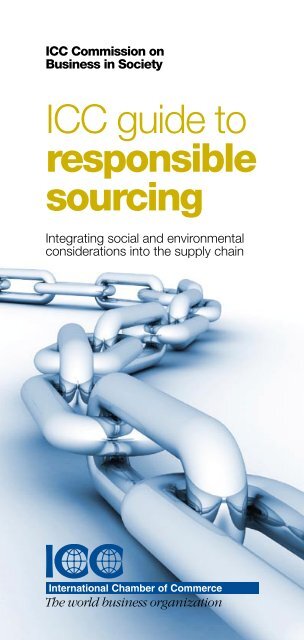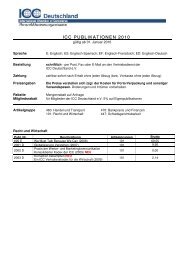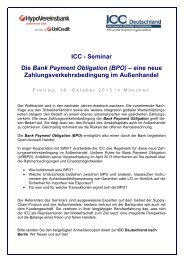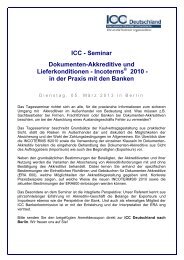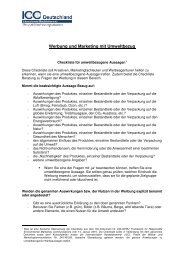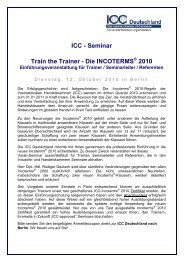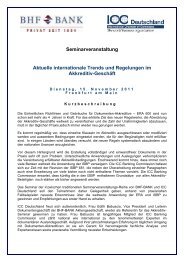ICC guide to responsible sourcing - International Chamber of ...
ICC guide to responsible sourcing - International Chamber of ...
ICC guide to responsible sourcing - International Chamber of ...
Create successful ePaper yourself
Turn your PDF publications into a flip-book with our unique Google optimized e-Paper software.
<strong>ICC</strong> Commission on<br />
Business in Society<br />
<strong>ICC</strong> <strong>guide</strong> <strong>to</strong><br />
<strong>responsible</strong><br />
<strong>sourcing</strong><br />
Integrating social and environmental<br />
considerations in<strong>to</strong> the supply chain<br />
1
Copyright © 2008<br />
<strong>International</strong> <strong>Chamber</strong> <strong>of</strong> Commerce<br />
Designed and produced by Rebus<br />
www.rebusparis.com<br />
Cover image © Sirin Buse/iS<strong>to</strong>ckPho<strong>to</strong><br />
2
Introducing<br />
<strong>responsible</strong> <strong>sourcing</strong><br />
What is <strong>responsible</strong> <strong>sourcing</strong>?<br />
Responsible <strong>sourcing</strong>, also referred <strong>to</strong> as supply<br />
chain responsibility, is a voluntary commitment<br />
by companies <strong>to</strong> take in<strong>to</strong> account social and<br />
environmental considerations when managing their<br />
relationships with suppliers.<br />
This strategy is now an integral part <strong>of</strong> effective<br />
supply chain management. As production chains<br />
expand, companies <strong>of</strong> all sizes and sec<strong>to</strong>rs are<br />
devoting more efforts <strong>to</strong> managing supply chain<br />
risks and building long-term supplier relationships.<br />
Improving social and environmental performance in<br />
production chains is becoming a major element <strong>of</strong><br />
this process.<br />
As experience has shown, one bad incident<br />
with one supplier can lead <strong>to</strong> a disproportionate<br />
amount <strong>of</strong> adverse publicity, damaging a company’s<br />
reputation and brand image. This has led<br />
a growing number <strong>of</strong> companies <strong>to</strong> develop and<br />
promote <strong>responsible</strong> <strong>sourcing</strong> practices.<br />
Indeed, effective supply chain management<br />
is a way for businesses <strong>to</strong> build a competitive<br />
advantage, especially in sec<strong>to</strong>rs where production<br />
is largely outsourced, such as clothing, footwear,<br />
electronics, or food products.<br />
For many companies, working <strong>to</strong>wards improving<br />
social and environmental standards in the supply<br />
chain has become a natural extension <strong>of</strong> their<br />
commitment <strong>to</strong> corporate responsibility and, as<br />
such, forms part <strong>of</strong> their overall business model.<br />
1
Getting involved<br />
Many companies have literally thousands <strong>of</strong><br />
suppliers across the globe. While a company<br />
cannot be held accountable for the actions <strong>of</strong> all<br />
its suppliers, its purchasing activities may create<br />
leverage <strong>to</strong> influence and moni<strong>to</strong>r its suppliers’<br />
conduct in areas such as working conditions,<br />
respect for labour rights and environmental<br />
protection.<br />
The ability <strong>of</strong> companies <strong>to</strong> influence their<br />
suppliers’ business conduct will vary greatly<br />
depending on the commercial environment in<br />
which they operate and the nature <strong>of</strong> their supplier<br />
relationships. The great diversity that exists within<br />
business requires companies <strong>to</strong> consider a range<br />
<strong>of</strong> <strong>to</strong>ols and approaches so that these can be<br />
tailored <strong>to</strong> their specific circumstances.<br />
To help companies develop their own approaches<br />
<strong>to</strong> <strong>responsible</strong> <strong>sourcing</strong>, this <strong>guide</strong> prepared by the<br />
<strong>International</strong> <strong>Chamber</strong> <strong>of</strong> Commerce (<strong>ICC</strong>) provides<br />
a series <strong>of</strong> practical steps from a global and multisec<strong>to</strong>ral<br />
perspective. These steps are based on<br />
real-life experiences collected from <strong>ICC</strong> member<br />
companies around the world, and can be used by<br />
companies <strong>of</strong> all sizes, sec<strong>to</strong>rs and regions.<br />
2
Six steps <strong>to</strong><br />
<strong>responsible</strong> <strong>sourcing</strong><br />
The following guidance presents basic steps<br />
that companies can take <strong>to</strong> influence and moni<strong>to</strong>r<br />
social and environmental performance in their<br />
global supply chains.<br />
Because not all suppliers pose risks, and many<br />
have good business practices already in place,<br />
a company should focus on high-risk areas,<br />
concentrating efforts where they are needed most<br />
and most likely <strong>to</strong> bring about change.<br />
Step one: selecting a supplier<br />
A careful selection <strong>of</strong> suppliers is one <strong>of</strong> the best<br />
ways <strong>to</strong> ensure continuity and long-term efficiency<br />
<strong>of</strong> the global supply chain as well as enduring<br />
brand support.<br />
When choosing a supplier, in addition <strong>to</strong> making a<br />
final determination on cost, companies <strong>of</strong>ten need<br />
<strong>to</strong> evaluate a range <strong>of</strong> supply chain issues: product<br />
quality and safety, continuity <strong>of</strong> supply and speed <strong>of</strong><br />
delivery, and intellectual property protection. Criteria<br />
such as working conditions, environmental practices,<br />
safety standards, and human rights policies should<br />
also be fac<strong>to</strong>red in<strong>to</strong> the selection process.<br />
When <strong>sourcing</strong> from low-income countries, a<br />
risk analysis should be conducted at the beginning,<br />
so that labour and environmental issues can be<br />
identified early on and integrated in<strong>to</strong> a cost-benefit<br />
analysis.<br />
As a first step, companies should check basic facts<br />
about the social and environmental legislation and<br />
the level <strong>of</strong> enforcement in the country <strong>of</strong> production,<br />
<strong>to</strong> assess potential production risks.<br />
3
Step two: set clear expectations<br />
on compliance with the law<br />
When contracting with a supplier, companies should<br />
make it known that they expect their business<br />
partners <strong>to</strong> comply with all national laws and<br />
regulations, including labour and environmental laws,<br />
and as appropriate, <strong>to</strong> take in<strong>to</strong> account principles<br />
from relevant international instruments, which may<br />
sometimes go beyond local legislation.<br />
These instruments include the <strong>International</strong> Labor<br />
Organization (ILO) Declaration on Funda men tal<br />
Principles and Rights at Work, other ILO conventions,<br />
and the Universal Declaration <strong>of</strong> Human Rights.<br />
Another useful reference is the Global Compact and<br />
its “10 principles” covering human rights, labour<br />
standards, the environment, and anti-corruption.<br />
A company can also adopt a supplier code <strong>of</strong><br />
conduct. Before doing so, it should consider the<br />
possible difficulties for suppliers <strong>to</strong> comply with the<br />
proliferation <strong>of</strong> such codes and their requirements.<br />
To ease the compliance burden on suppliers, which<br />
are <strong>of</strong>ten small and medium-sized enter prises, a<br />
company may consider partnering with a sec<strong>to</strong>ral<br />
association that has developed an industry-wide<br />
supplier code <strong>of</strong> conduct.<br />
Examples <strong>of</strong> such initiatives include the Busi ness<br />
Social Compliance Initiative, the Electronics Industry<br />
Citizenship Coalition and the <strong>International</strong> Council <strong>of</strong><br />
Toy Industries CARE Foundation.<br />
Step three: integrate <strong>responsible</strong> <strong>sourcing</strong><br />
in<strong>to</strong> buying practices<br />
By integrating <strong>responsible</strong> <strong>sourcing</strong> in<strong>to</strong> its own<br />
buying practices, a company should avoid undermining<br />
the capacity <strong>of</strong> suppliers <strong>to</strong> respect social and<br />
environmental standards. Inefficient practices, such<br />
as rush orders, last-minute changes or placing orders<br />
that surpass suppliers’ capabilities, which <strong>of</strong>ten lead<br />
<strong>to</strong> excessive overtime work and other compliance<br />
violations, should be avoided.<br />
4
A company can initiate direct improvements in two<br />
ways: by raising awareness among its corporate<br />
buyers <strong>of</strong> the impact their decisions might have at<br />
fac<strong>to</strong>ry level; and by encouraging more coordination<br />
among corporate buyers, a supplier’s sales team,<br />
and production units when planning production<br />
schedules.<br />
Step four: support suppliers in setting<br />
their own business standards<br />
A company should encourage suppliers <strong>to</strong> deve lop<br />
their own <strong>responsible</strong> practices rather than imposing<br />
requirements on them. In doing so, it is essential<br />
<strong>to</strong> stress the commercial benefits <strong>of</strong> <strong>responsible</strong><br />
business practices on quality, productivity, contract<br />
renewals, and lowering employee turnover.<br />
To help them internalize change, suppliers should<br />
be directly involved in the shaping <strong>of</strong> perfor mance<br />
objectives. This way, suppliers can integrate these<br />
objectives in<strong>to</strong> their own business strategy, based<br />
on their individual capacity and needs.<br />
If useful, a company can provide training <strong>to</strong> its<br />
suppliers <strong>to</strong> help them improve their management<br />
practices and performance. Such support is an<br />
integral element <strong>of</strong> the knowledge transfer that<br />
comes with <strong>sourcing</strong>. Training programmes for<br />
management and employees may cover supervisory<br />
skills, environmental management, and raising<br />
awareness <strong>of</strong> health and safety practices.<br />
In sec<strong>to</strong>rs where labour or health and safety risks<br />
may be present further down the supply chain, a<br />
company can also work with its direct suppliers <strong>to</strong><br />
ensure that social and environmental considerations<br />
in turn play a role in their relations with second and<br />
third tier suppliers.<br />
5
Step five: track supplier compliance<br />
Companies can ask their suppliers <strong>to</strong> provide<br />
comprehensive information about their social and<br />
environmental practices. On-site visits can also be<br />
organized <strong>to</strong> moni<strong>to</strong>r suppliers’ progress, or lack<br />
<strong>of</strong> progress, in meeting social and environmental<br />
performance objectives. Evaluating this information<br />
may become part <strong>of</strong> a company’s regular assessments<br />
<strong>of</strong> business requirements, such as quality<br />
control.<br />
To make performance checks truly effective,<br />
companies should involve their suppliers’ fac<strong>to</strong>ry<br />
management and workers in moni<strong>to</strong>ring, and give<br />
them the training and <strong>to</strong>ols <strong>to</strong> develop their own<br />
compliance system and <strong>to</strong> identify problems.<br />
Taking a risk-based approach can help with a<br />
large base <strong>of</strong> suppliers when moni<strong>to</strong>ring social<br />
and environmental compliance. Companies should<br />
focus on high-risk suppliers rather than moni<strong>to</strong>ring<br />
across the board, as well as on suppliers in charge<br />
<strong>of</strong> the main steps in the production process.<br />
A company can save moni<strong>to</strong>ring costs by colla borating<br />
with other companies from the same sec<strong>to</strong>r<br />
and developing common approaches for auditing<br />
suppliers.<br />
To harmonize moni<strong>to</strong>ring practices and ease the<br />
compliance burden <strong>of</strong> suppliers, several sec<strong>to</strong>r<br />
associations have brought <strong>to</strong>gether manufacturers<br />
<strong>of</strong> branded goods, suppliers, retailers and cus <strong>to</strong>mers<br />
with a view <strong>to</strong> develop common <strong>to</strong>ols and<br />
rationalize supply chain requirements.<br />
Initiatives which bring <strong>to</strong>gether non-governmental<br />
organizations, trade unions and companies can<br />
also help encourage dialogue and build overall<br />
confidence in the compliance process.<br />
6
Step six: manage stakeholder expectations<br />
and reporting<br />
To build cus<strong>to</strong>mer trust, companies can collect<br />
information on supplier performance across<br />
markets, and publish it in an annual report or other<br />
publicly-available format. Reporting efforts should<br />
be used <strong>to</strong> measure performance and flag areas<br />
for improvement.<br />
Some companies also choose <strong>to</strong> validate their first<br />
or second-party moni<strong>to</strong>ring (audits conducted by<br />
the company or on behalf <strong>of</strong> a company by another<br />
organization) by third-party moni<strong>to</strong>ring (conducted<br />
by independent bodies). A company’s strategy<br />
in this area will <strong>of</strong>ten be shaped by the way it<br />
manages its broader stakeholder relationships,<br />
for example its relations with consumers and local<br />
communities.<br />
7
Minding supply chain<br />
gaps<br />
The various steps set forth in this <strong>guide</strong> are meant<br />
<strong>to</strong> help companies define their basic approach <strong>to</strong><br />
<strong>responsible</strong> <strong>sourcing</strong>.<br />
However it is important <strong>to</strong> bear in mind that<br />
integrating social and environmental considerations<br />
in global supply chains is a shared responsibility<br />
that embraces a wide range <strong>of</strong> ac<strong>to</strong>rs.<br />
The role <strong>of</strong> government<br />
Responsible <strong>sourcing</strong> can go a long way <strong>to</strong>wards<br />
improving social and environmental practices<br />
across industries and production chains. But no<br />
long-term progress is possible without greater<br />
government involvement in passing and enforcing<br />
laws.<br />
The positive role <strong>of</strong> many governments in this<br />
area should be highlighted. In some parts <strong>of</strong> the<br />
world, however, the will or capacity <strong>of</strong> governments<br />
<strong>to</strong> enforce basic rules is lacking. In such cases,<br />
voluntary initiatives by companies can help fill the<br />
gap, but should not be considered as a substitute<br />
<strong>to</strong> government action.<br />
Some governments should be reminded <strong>of</strong> the<br />
significant economic and social benefits that flow<br />
from effective regulation and enforcement. The<br />
drive for higher social and environmental standards<br />
can lead <strong>to</strong> increased productivity and greater<br />
competitiveness, which in turn attracts investment<br />
and helps local businesses move up the value<br />
chain.<br />
8
Government action also captures entire<br />
economies, since national social and environmental<br />
regulations are not confined <strong>to</strong> export-oriented<br />
sec<strong>to</strong>rs, thereby contributing <strong>to</strong> broad economic<br />
development and the achievement <strong>of</strong> higher living<br />
standards.<br />
How <strong>to</strong> deal with non-performance<br />
Improving social and environmental performance in<br />
global supply chains can only be achieved with the<br />
effective participation <strong>of</strong> stakeholders at all levels,<br />
including suppliers which are directly in charge <strong>of</strong><br />
integrating social and environmental standards in<strong>to</strong><br />
their business operations.<br />
However, companies must be prepared <strong>to</strong> face the<br />
risk <strong>of</strong> non-compliance in their supply chain.<br />
When suppliers do not meet expectations, or<br />
when a company discovers a serious compliance<br />
violation, the company should agree with the<br />
supplier on a realistic timetable <strong>of</strong> improvements.<br />
If solutions cannot be found and performance does<br />
not improve, termination <strong>of</strong> relationship should<br />
be seriously considered, but only as a last resort.<br />
Deciding <strong>to</strong> terminate a supplier relationship should<br />
be carefully weighed as it may deprive a supplier<br />
<strong>of</strong> the resources necessary <strong>to</strong> improve business<br />
practices and lead <strong>to</strong> worsening worker conditions.<br />
9
Moving forward<br />
with <strong>responsible</strong><br />
<strong>sourcing</strong><br />
A checklist for companies engaged<br />
in supply chain relationships<br />
The following checklist summarizes some <strong>of</strong> the<br />
important steps that companies can take when<br />
entering supply chain relationships:<br />
n Check basic facts about the social and<br />
environmental legislation in the countries <strong>of</strong><br />
production <strong>of</strong> prospective suppliers. Find out<br />
about the level <strong>of</strong> enforcement in these countries<br />
<strong>to</strong> assess production risks.<br />
n Check whether prospective suppliers qualify<br />
for independent certification <strong>of</strong> conformity with<br />
recognized social and environmental standards.<br />
n Clearly define your expectations <strong>to</strong> your<br />
suppliers. Make clear that compliance with all<br />
applicable laws is a minimum.<br />
n Explore potential risk areas with suppliers<br />
and agree on the desired level <strong>of</strong> performance.<br />
If necessary, use a supplier code <strong>of</strong> conduct as<br />
a benchmark for compliance and incorporate<br />
supplier requirements in<strong>to</strong> commercial contracts.<br />
n Raise awareness among your purchasing<br />
<strong>of</strong>ficers <strong>of</strong> the impact that their purchasing<br />
practices might have on production at fac<strong>to</strong>ry level.<br />
n Carry out assessments <strong>of</strong> suppliers’ facilities<br />
and practices, including through independent<br />
moni<strong>to</strong>ring where appropriate, or by organizing onsite<br />
visits and worker interviews.<br />
10
n Find out about sec<strong>to</strong>ral initiatives which can<br />
help conduct assessments and provide information<br />
and training <strong>to</strong> suppliers on <strong>responsible</strong> business<br />
practices.<br />
Some examples <strong>of</strong> <strong>responsible</strong><br />
<strong>sourcing</strong> initiatives<br />
A number <strong>of</strong> initiatives led by sec<strong>to</strong>ral associations<br />
and multi-stakeholder bodies have emerged<br />
with a view <strong>to</strong> provide more specific guidance<br />
on basic requirements which can be expected<br />
from suppliers, as well as <strong>to</strong> develop operative<br />
frameworks for conducting supplier assessments<br />
and training programmes.<br />
Participation in such initiatives can come with<br />
important benefits in terms <strong>of</strong> harmonizing<br />
approaches and fostering dialogue. Examples <strong>of</strong><br />
well-known initiatives include the following:<br />
n The Business Social Compliance Initiative<br />
(www.bsci-eu.org), a European business-driven<br />
platform for the improvement <strong>of</strong> social compliance<br />
in all supplier countries and for all consumer<br />
goods;<br />
n The ICTI-CARE process (www.icti-care.org), the<br />
international <strong>to</strong>y industry’s ethical manufacturing<br />
programme, aimed at ensuring safe and humane<br />
workplace environments for <strong>to</strong>y fac<strong>to</strong>ry workers<br />
worldwide;<br />
n The Electronic Industry Code <strong>of</strong> Conduct<br />
(www.eicc.info), a code <strong>of</strong> best practices adopted<br />
and implemented by some <strong>of</strong> the world’s major<br />
electronics brands and their suppliers with a view<br />
<strong>to</strong> improve conditions in the electronics supply<br />
chain;<br />
n The Fair Labour Association (www.fairlabor.<br />
org), a network <strong>of</strong> companies, civil society<br />
organizations, and universities protecting workers’<br />
rights and improving working conditions worldwide<br />
by promoting adherence <strong>to</strong> international labour<br />
standards;<br />
11
n The Ethical Trading Initiative (www.ethicaltrade.<br />
org), an alliance <strong>of</strong> companies, non-governmental<br />
organizations and trade union organiz ations<br />
which promotes the implementation <strong>of</strong> corporate<br />
codes <strong>of</strong> practice covering supply chain working<br />
conditions;<br />
n Worldwide Responsible Apparel Production<br />
(www.wrapapparel.org), an independent<br />
organization dedicated <strong>to</strong> the certification <strong>of</strong> lawful,<br />
humane and ethical manufacturing in apparel<br />
production;<br />
n SA8000 (www.sa-intl.org), a comprehensive<br />
system for managing ethical workplace conditions<br />
throughout global supply chains.<br />
Whatever mechanism is used, it is important <strong>to</strong><br />
remember that the most effective way <strong>to</strong> achieve<br />
sustained improvement over time is by developing<br />
a long-term collaborative approach between<br />
companies and their suppliers, through the<br />
involvement <strong>of</strong> local management and employees<br />
in the shaping <strong>of</strong> social and environmental<br />
performance objectives.<br />
12
Further reading<br />
and references<br />
For further background on <strong>responsible</strong> <strong>sourcing</strong>,<br />
the following papers will provide useful reading:<br />
n <strong>ICC</strong> guidance on supply chain<br />
responsibility – Policy statement by the<br />
<strong>International</strong> <strong>Chamber</strong> <strong>of</strong> Commerce,<br />
Oc<strong>to</strong>ber 2007<br />
n Beyond moni<strong>to</strong>ring: a new vision for<br />
sustainable supply chains – Business for<br />
Social Responsibility, July 2007<br />
n Corporate social responsibility in China’s<br />
information and communications technology<br />
sec<strong>to</strong>r – Foreign Investment Advisory Service and<br />
Business for Social Responsibility, July 2007<br />
n Meaningful change: raising the bar<br />
in supply chain working standards –<br />
Roseann Casey, prepared for John Ruggie,<br />
UN Secretary-General Special Representative on<br />
business and human rights, November 2006<br />
n Assurance for sustainable supply chains<br />
– Fédération des Experts Comptables Européens,<br />
June 2005<br />
n Strengthening implementation <strong>of</strong><br />
corporate social responsibility in global<br />
supply chains – World Bank Group,<br />
Oc<strong>to</strong>ber 2003<br />
13
<strong>ICC</strong> is the world business organization,<br />
a representative body that speaks with authority<br />
on behalf <strong>of</strong> enterprises from all sec<strong>to</strong>rs in every part<br />
<strong>of</strong> the world. <strong>ICC</strong> promotes an open international<br />
trade and investment system and the market<br />
economy, and helps business corporations meet<br />
the challenges and opportunities <strong>of</strong> globalization.<br />
Business leaders and experts drawn from <strong>ICC</strong>’s<br />
global membership establish the business stance<br />
on broad issues <strong>of</strong> trade and investment policy<br />
as well as on vital technical subjects.<br />
<strong>ICC</strong> was founded in 1919 and <strong>to</strong>day it groups<br />
member companies and associations in 130<br />
countries.<br />
<strong>ICC</strong> Commission on<br />
Business in Society<br />
This <strong>guide</strong> <strong>to</strong> <strong>responsible</strong> <strong>sourcing</strong> has been<br />
developed by the <strong>ICC</strong> Commission on Business<br />
in Society. The commission is <strong>ICC</strong>’s main working<br />
body on corporate responsibility issues, helping<br />
<strong>to</strong> define the role <strong>of</strong> business in the context <strong>of</strong><br />
globalization and changing societal expectations.<br />
Members <strong>of</strong> the commission are senior corporate<br />
responsibility executives within global companies<br />
in a variety <strong>of</strong> sec<strong>to</strong>rs.<br />
For further reading about <strong>responsible</strong> <strong>sourcing</strong><br />
and other commission activities, please visit<br />
www.iccwbo.org/policy/society or email<br />
julian.kassum@iccwbo.org<br />
38 Cours Albert 1er, 75008 Paris, France<br />
Tel: +33 (0)1 49 53 28 28<br />
Fax: +33 (0)1 49 53 28 59<br />
www.iccwbo.org<br />
16


